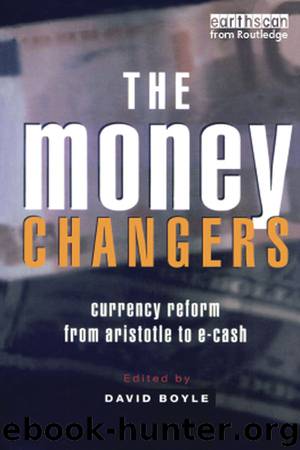The Money Changers by Boyle David;

Author:Boyle, David;
Language: eng
Format: epub
ISBN: 4217752
Publisher: Routledge
PART V INTRODUCTION
FUTURE MONEY
For in every country of the world, I believe, the avarice and injustice of princes and sovereign states abusing the confidence of their subjects, have by degrees diminished the real quality of the metal, which had been originally contained in their coins.
ADAM SMITH, QUOTED BY F A HAYEK IN HIS PAMPHLET THE DE-NATIONALIZATION OF MONEY
Money is coined liberty.
FYODOR DOSTOEVSKY
The money historian Glyn Davies says that the history of money is also the story of the slow loss of control by governments over money. With each new innovation, from paper money to e-cash, the power over money slips out of the hands of the state just a little bit further. And perhaps that’s not surprising: money may have been the cause of countless wars and disasters of human greed, but it has also been the great equalizer. It recognizes no religious scruple and no aristocracy – and in the end sweeps both away. In that sense, the development of money has been about spreading the wings of human liberty from church and state.
But of course that isn’t the end of the story either. Monetary developments have also often led down the most bizarre blind alleys, as the Promethean money innovators struggle to control the fire they have created. The Chinese gave up paper currency before it spread to the West because it caused hyperinflation (see Marco Polo, p139); John Law escaped with his life from Paris after his innovations turned French society upside down (see p142). Even so, there are recognizable dreams that recur over and over again through this part.
There’s the dream of disconnecting money from state control, repeated in different ways through economists like Hayek (see p157) or cryptographers like Chaum (see p164) – though as John Law and Marco Polo found out, paper money requires a strong legal context to give it value. There’s the dream that money could disappear completely, repeated in different ways through utopians like William Morris (see p153) and economists like Fischer Black (see p155).
There’s also the mirror-image dream that money might be developed in more targeted ways to improve society, repeated in rather frightening forms by novelists like Edward Bellamy (see p148) and psychologists like B F Skinner (see Part IV, p127) – and in more practical ways by the creativity guru Edward de Bono (see p168).
And through many of these passages, the same theme emerges of money and information slowly collapsing together, with writers like Birch and McEvoy (see p171) dreaming of a whole range of competing currencies for different aspects of life, which to some extent we can already see around us. Even back in 1867, the British colony of Singapore made a whole series of currencies legal tender, including those of Hong Kong, Mexico, Bolivia and Peru, adding the yen and the US dollar to the approved list later. Anyone who has visited the duty free shop in Moscow airport over the past decade will have experienced something similar because they could pay in any one of 20 or so currencies at the same till.
Download
This site does not store any files on its server. We only index and link to content provided by other sites. Please contact the content providers to delete copyright contents if any and email us, we'll remove relevant links or contents immediately.
The Meaning of the Library by unknow(2390)
Six Billion Shoppers by Porter Erisman(2229)
Why Nations Fail: The Origins of Power, Prosperity, and Poverty by Daron Acemoglu & James Robinson(2178)
No Time to Say Goodbye(1998)
Red Notice by Bill Browder(1933)
The Economist [T6, 22 Thg9 2017] by The Economist(1845)
Currency Trading For Dummies by Brian Dolan(1792)
Thank You for Being Late by Thomas L. Friedman(1680)
Bitcoin: The Ultimate Guide to the World of Bitcoin, Bitcoin Mining, Bitcoin Investing, Blockchain Technology, Cryptocurrency (2nd Edition) by Ikuya Takashima(1615)
Amazon FBA: Amazon FBA Blackbook: Everything You Need To Know to Start Your Amazon Business Empire (Amazon Empire, FBA Mastery) by John Fisher(1496)
Coffee: From Bean to Barista by Robert W. Thurston(1420)
The Future Is Asian by Parag Khanna(1402)
The Great Economists by Linda Yueh(1392)
Capitalism Without Capital: The Rise of the Intangible Economy by Jonathan Haskel(1342)
Pocket World in Figures 2018 by The Economist(1329)
How Money Got Free: Bitcoin and the Fight for the Future of Finance by Brian Patrick Eha(1322)
Grave New World by Stephen D. King(1317)
The Sex Business by Economist(1283)
Cultural Intelligence by David C. Thomas(1204)
